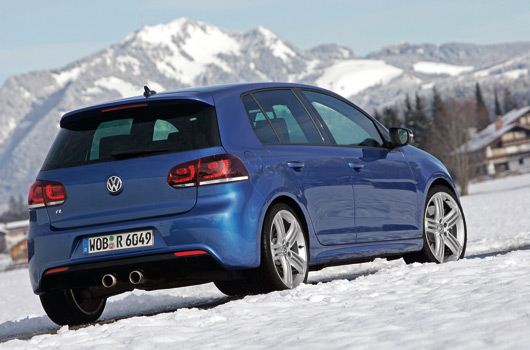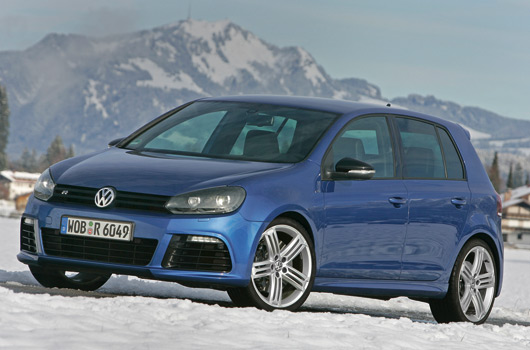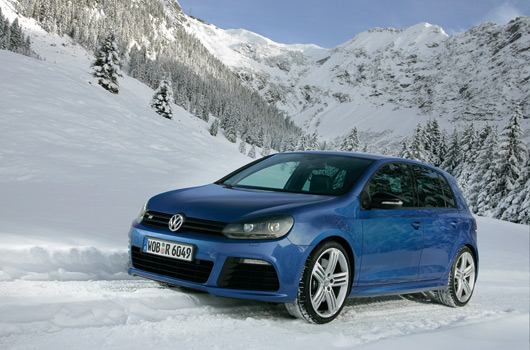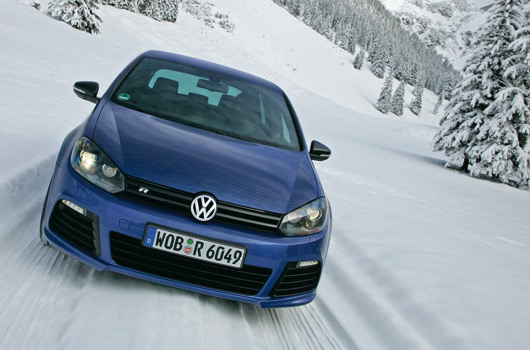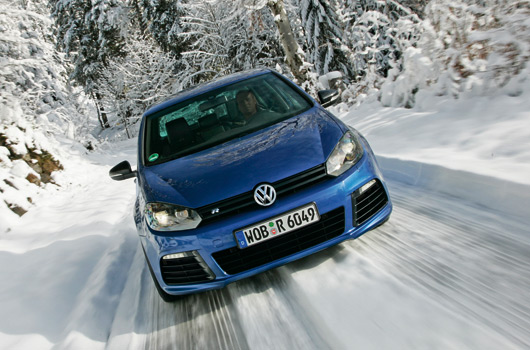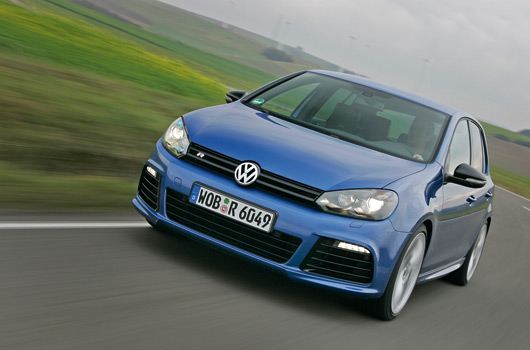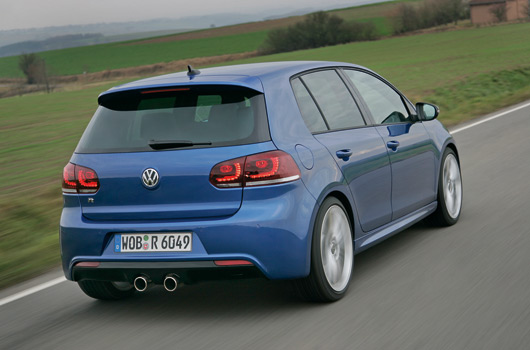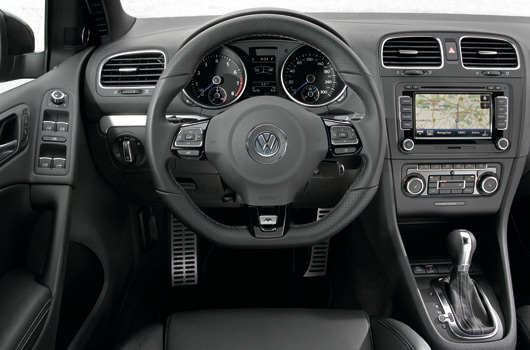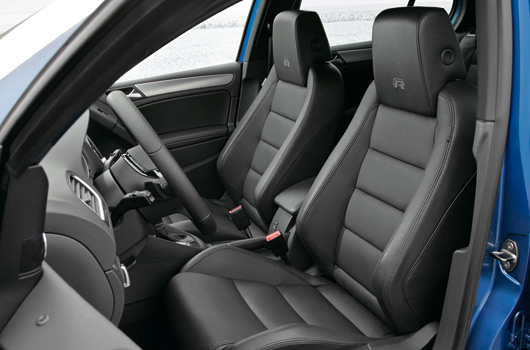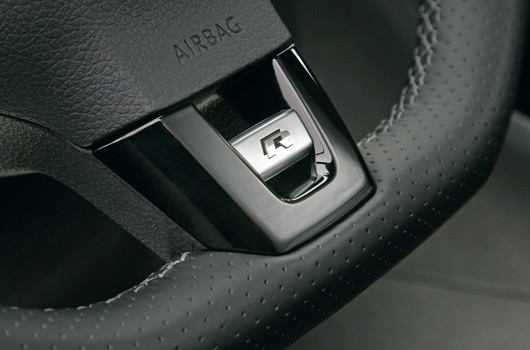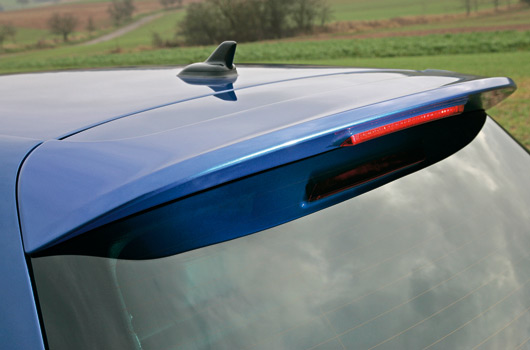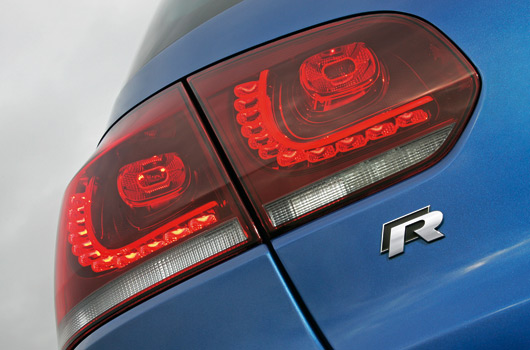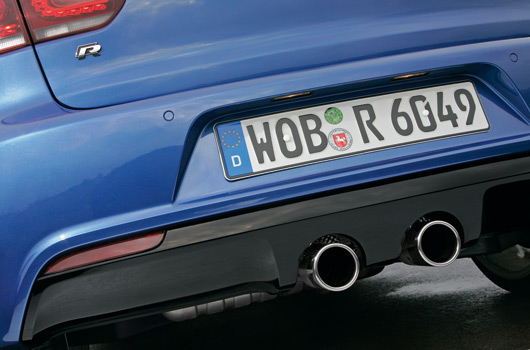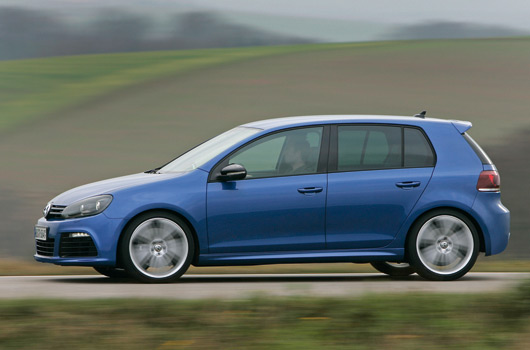Volkswagen have taken to the hills of Austria with their eagerly anticipated 199kW all-wheel drive Golf R. Providing music to the ears of Australian fans of this car, we know the new R will be coming, but we don’t know when. Depending on who you ask, the estimated time of arrival varies from as soon April-May, to as far away as October. My educated guess, based on comments from VW Australia’s MD, is we will see the Golf R down under somewhere around the middle of the year. To cover my bases a bit, let’s allow a couple of months either way.
As for Australian pricing of the Golf R, again, speculation is rife. Some people reckon the car will be in the low $50K range. Frankly, I think that is overly optimistic. If I was planning to buy a Golf R I’d be budgeting on a starting price for a 3-door manual around the $56-59K range, with on-roads and options to be added.
One thing is sure, when Volkswagen Australia lets us know the real deal, you will be able to read all about it here on AUSmotive. Speaking of reading all about it, after the jump is a mega-press release from Volkswagen AG, as well as a dozen or so new images. If you want this car it might be a sound idea to bookmark this URL as the info provided will serve as a great reference point while you’re waiting for your new pride and joy to arrive.
The Golf R—International Driving Presentation, Ellmau 2010
R Concentrate—More Power, Less Fuel
- New Golf R with 270 PS and 8.5 Litre Combined Fuel Consumption
- Frugal – Golf R has most powerful TSI ever, yet it consumes just 8.4 litres as DSG
- Exceptional – Top Golf with all-wheel drive has superior handling
Wolfsburg/Ellmau, 25 January 2010 – The new Golf R is here. Designed by Volkswagen Individual. All-wheel driven. As the flagship of the model series it is equipped with standard Bi-Xenon headlights, LED daytime running lights and LED rear lights. Shifted manually or by optional DSG. At 199 kW / 270 PS it is the most powerful version of the model series ever built. At the same time, it is the most fuel-efficient Golf R of all times – 21 percent (!) more fuel efficient than the previous model. A high-class sports car with compact-class fuel economy. The data in detail: The Golf R sprints from 0 to 100 km/h in just 5.7 seconds. The Golf R performs even better when shifted with the optional direct shift gearbox (DSG): It leaves the 100-km/h mark behind it in a sensational 5.5 seconds. The best data: While the retired Golf R32 processed 10.7 litres fuel per 100 kilometres, the new Golf R only needs 8.5 litres – 2.2 litres less! Accordingly, CO2 emissions are reduced from 255 to 199 g/km. After 100 kilometres, the automatically shifted Golf R DSG is filled with just 8.4 litres (195 g/km CO2) at the fuel pump.
The enormous efficiency gain of the new Golf R is not some magic trick; rather it is the result of intelligent downsizing. Its legendary predecessor generated its power from a displacement of 3.2 litres (“32”) and six cylinders. In the new model, this is accomplished with four cylinders and 2.0 litres of displacement – a highly advanced direct injection petrol engine with turbo-charging (TSI). At the fuel pump and on the winding mountain road, this high-tech alliance is superior to a classic six cylinder with multi-point injection. Proving that even the sound of a four cylinder can leave a strong impression are the fifth and sixth generations of the Golf GTI, also powered by a four cylinder TSI. And the Golf R – and the chrome dual tailpipes of its sound-optimized exhaust system – display a significantly broader “sound spectrum”.
The TSI’s torque characteristic is just as impressive. By comparison: The six cylinder of the previous model developed a maximum torque of 320 Newton-meters at 2,500 rpm. And that too was remarkably good. The turbo four-cylinder direct injection engine of the new Golf R, on the other hand, transfers 350 Newton-meters torque to the crankshaft, also available from 2,500 rpm, but it can maintain this peak value up to 5,000 rpm. So the new car delivers a fascinatingly high level of fundamental dynamic performance. The Golf R32 and Golf R are really only equals in one discipline; they each have a top speed of 250 km/h (electronically limited on the Golf R).
TSI of the Golf R
The new Golf R uses the EA113 series direct-injection petrol engine; its turbocharger makes it very flexible and variable right up to the highest end of the performance curve. The 1,984 cm3 TSI’s specific power is a respectable 100.3 kW / 136.6 PS per litre displacement, and its responsiveness is just as impressive. The engine’s power can be spontaneously summoned in the blink of an eye over its entire speed range. As mentioned, the engine also shows off its potential acoustically. Visually too: Its two chrome tailpipes are visible under the diffuser integrated at the centre of the bumper – an “R trait” of the previous model as well.
The four-cylinder engine develops its tremendous propulsive power via a turbocharger (up to 1.2 bar boost pressure) with intercooling. The engine, weighing in at just 152 kilograms, is controlled by a fully electronic engine management system with E-Gas. The cylinders of the four-cylinder engine have been equipped with reinforcing bolts, unlike less powerful TSI versions. Design engineers also designed stronger connecting rods that can reliably transfer the engine’s high torque to the crankshaft. Last but not least, the cylinder block was reinforced to handle the aggressive engine forces.
All-wheel drive of the Golf R
The Golf R transfers the TSI’s power to the road via the latest generation of Volkswagen’s 4MOTION all-wheel drive system, which is standard equipment. Compared to the version implemented in the Golf R32, the system underwent significant advanced development. Above all, power transmission between the front and rear axles – especially the all-wheel differential that operates in an oil bath – demonstrates clear advantages compared to the previous generation. The most important one: Activation of the all-wheel differential no longer requires a difference between the front and rear axle speeds.
That is because, and this is different than on the previous generation, an electric pump is being used to build pressure for the first time. The electric pump supplies oil to a hydraulic reservoir with a working pressure of 30 bar. A control module computes the ideal drive torque for the rear axle, and it uses a valve to control how much oil pressure is applied to the working pistons of the multi-plate clutch. The contact pressure at the clutch plates rises in proportion to the desired torque at the rear axle. The amount of torque that is transferred can be varied continuously by the amount of pressure applied to the clutch plates. Unlike the previous 4MOTION generation, the system operates independent of slip, since the system’s working pressure is always available. When starting up and accelerating, spinning of the wheels at the front axle is prevented more effectively, since the control module regulates torque distribution based on dynamic axle loads. In extreme cases, nearly 100 percent of the drive torque can be directed to the rear axle, a plus in terms of active safety and dynamic performance.
Sport chassis of the Golf R
When it came to the running gear, development engineers adopted the first-class system of the current production Golf. This means: In front the familiar McPherson strut suspension with helical springs and telescoping shock absorbers; at the rear a multi-link suspension ensures that the standard ESP system seldom needs to intervene. The basic layout was transformed into a sport chassis with ride-height lowered 25 millimetres, and the springs, dampers and stabilisers were completely re-tuned to this new configuration. Also available as an option is DCC dynamic chassis control whose character was fully tuned to the Golf R. This system continually adapts suspension damping to the roadway and driving situation. In addition to the standard “Normal” mode, the driver can manually activate a “Sport” or “Comfort” mode.
The brake system was also modified for the Golf R’s higher level of driving performance. Instead of a 16-inch system, a 17-inch brake system is used; all brakes have internally ventilated discs and R-specific brake callipers painted a high-gloss black with R-logo. In front the discs are 345 millimetres in diameter, and 310 millimetres at the rear. The electronic stabilisation program (ESP) was also modified. It can be switched to a new Sport mode via the ESP button. During very fast and curve-filled drives – as on a circuit – the ESP system delays intervention, enabling even more responsive handling properties. The electro-mechanical power-assisted steering was given a sportier characteristic as well. If the Golf R is ordered with optional DCC dynamic chassis control, the power-assisted steering is given a specially tuned characteristic for each of the system’s driving modes (“Sport”, “Normal”, “Comfort”).
The running gear maintains its contact with the road via new 18-inch alloy wheels (“Talladega” type in “Sterling Silver” colour) with 225/40 tyres as standard equipment. The same style wheels are available in a 19-inch version with 235/35 tyres as an option. Customers can also order the 19-inch wheels in “Glossy Black”. Regardless of the colour, when 19-inch wheels are selected the headlight housings always appear completely in black, and the Golf R windows are tinted from the B-pillars back.
Exterior features of the Golf R
Like the first two generations of the Super Golf (I starting in 2002, II in 2005) – and the car’s new sister model the Scirocco R – the new Golf R also sports an entirely new set of exterior and interior features. Volkswagen designers have given the Golf R independent styling with a bundle of well-coordinated refinements, including large air scoops to meet the cooling demands of the 270-PS engine. The Golf R clearly represents the peak of the model series, and the quality of its styling follows the basic design language of “La Semplicità ” set forth by the Head of Group Design, Walter de Silva.
Outside, it is customised by features such as the new “Talladega” style wheels, black brake callipers with R-logo and new bumper design. In front, three very large air intakes shape the front bumper section of the Golf R; louvres on the intakes are painted in high-gloss black, and standard LED strips that serve as daytime running lights are integrated in the two outer air intakes. Also painted in high-gloss black are the two louvres of the radiator grille. A new R-logo design appears in chrome on the right side of the grille. Bi-Xenon headlights with dynamic cornering light, included at no extra charge, illuminate the way through the night. On its sides, the Golf R is recognisable by side skirt extensions in body colour and mirror housings painted in high-gloss black.
The Golf R can be clearly made out as an independent top model at the rear as well. The rear lights, a new design, stands out along with the bumper with diffuser and centrally positioned tailpipes, R-logo and larger roof edge spoiler. They operate with standard LED technology that is visually distinctive and exhibits extremely quick response as well as long in life.
Interior features of the Golf R
The sixth generation Golf, with its high-end interior materials, breaks through class distinctions to the next higher class. The Golf R benefits from this quality image too; its power reserves alone put it in a league of its own. Additional special upgrades developed by Volkswagen Individual highlight the car’s high-end positioning.
A key equipment option here is the newly designed “Top Sport seat system” with heated seats in front that have excellent ergonomic properties. The driver just sits down, adjusts the longitudinal and height positions of the seat, adjusts the steering wheel, buckles up, and is ready to go. The seat fits as though it were tailor-made. Here, the Golf R – together with the Golf GTI and Golf GTD – is setting standards among the international competition. The centre panels of the sport seats are upholstered in the honeycomb textured grey-black “Kyalami” design – named after the race course of the same name in South Africa; the front edge of the seat is upholstered in Titan Black fabric. The inside panels of the side supports are upholstered with crystal-grey “San Remo” micro-fibres. The rest of the seat components and the roofliner are coloured black. The new R-logo is embroidered in the front head restraints as well. Motorsport shell seats for driver and front passenger are also available as an option; they have integrated head restraints with embroidered R-logos. In this case, the centre seat panels are upholstered in the “San Remo” micro-fibre fabric. On the outside, the shell seats are upholstered with black leather.
All seams of the interior are in “Art Grey” (exception: Motorsport shell seats). As so are the decorative seams of the standard multi-function three-spoke leather steering wheel. Perforated leather is used at the top and bottom of the steering wheel, ensuring maximum hand grip. The sides of the steering wheel with their ergonomic motorsport attributes are fully trimmed in leather. Spokes in fine black piano paint add an elegant aspect that finishes the sporty image. The centre steering wheel spoke bears the R-logo. The fascinating material contrast of piano paint and chrome conveys the passion for finesse and precision in every detail of the interior.
Also re-styled are the R gearshift knob, carpet floor mats with piping in “Art Grey”, aluminium door tread plates with R-logo and the instruments with their blue pointers and a speedometer scale that reads up to 300 km/h. Stainless steel sport pedals and R-specific instrument and door accents in “Silver Lane” styling round out the custom features. Standard equipment on the Golf R also includes an automatic climate control system (“Climatronic”) and the “RCD 310” radio-CD system (4 x 20 Watt) with MP3 player plus dual tuners.
Overview of standard equipment of the Golf R
Exterior and wheels
- Alloy wheels (4), “Talladega” type, 7 1/2 J x 18, wheel locks for added theft protection, tyres 225/40 R 18
- Bi-Xenon headlights with dynamic cornering light
- Brake callipers in black with R-logo
- Bumpers in motorsport look, painted body colour
- Door mirror housings in glossy black
- Dual tailpipes in the centre
- Radiator grille black with R-logo
- Rear lights in LED technology, smoked
- Rear spoiler in body colour
- Side skirt extensions in body colour
Interior
- Cargo pass-through in rear bench with rear centre armrest
- Cargo space trim panels with additional bin on right
- Chrome surround on rotary light switch, chrome accents on mirror adjustment and window lift switches
- Decorative inserts in “Silver Lane” aluminium on instrument panel and door trim panels
- Door and side trim in leather look with Art Grey decorative seams
- Fabric seat covers in “Kyalami” design, with R-logo in front head restraints, inner surfaces of side supports in “San Remo” micro-fibre with decorative seams in Art Grey
- Front centre armrest in leather look with decorative seams in Art Grey, with storage box, 2 air nozzles and 2 cup holders in rear
- Front tread plates in aluminium with R-logo
- Hand brake grip leather-trimmed with Art Grey decorative seams
- Heated front seats
- Leather-trimmed gearshift grip with aluminium accents and glossy black look as well as Art Grey decorative seams
- Lumbar supports in front
- Multi-function leather-trimmed steering wheel (3 spokes) with gear shift controls; glossy black accents, R-logo and Art Grey decorative seams; controls for multi-function display, radio and telephone
- Multi-function leather-trimmed steering wheel with Tiptronic controls for DSG with shift paddles, glossy black decor and R-logo and Art Grey decorative seams; controls for multi-functional display, radio and telephone
- Pedals in stainless steel
- R-logo above the glove box
- Roofliner in black
- Storage compartment with hinged door in roofliner
- Storage pockets on front seat backrests
- Top sport seats in front, height adjustable
- Woven floor mats, front and rear, with piping in Art Grey
Safety
- ParkPilot, acoustic signals warn of obstacles in front of and behind the vehicle
Functional
- “Climatronic” climate control system
- “Plus” anti-theft alarm system
- “Plus” multi-function display
- “RCD 310” radio system
- 12-V appliance outlet in cargo space
- All-wheel drive
- Door mirrors with passenger side mirror lowering and automatic dimming
- Headlight cleaning system
- Hill Hold Control is standard with DSG
- Illuminated vanity mirrors in sun visors
- LED daytime running lights in bumper
- Rain sensor
- Reading lamps with chrome surrounds in front (2) and in the rear (2)
- Sport chassis, ride height lowered by approx. 25 mm
- Tyre pressure indicator
- Warning lamp for washer fluid level
- Windscreen washer nozzles in front, automatically heated
Note: Equipment information and technical data apply to models offered in Germany. They may differ in other countries. All information subject to change and correction. TDI, TSI, DSG and Twincharger are registered trademarks of Volkswagen AG or other companies of the Volkswagen Group in Germany and other countries.
